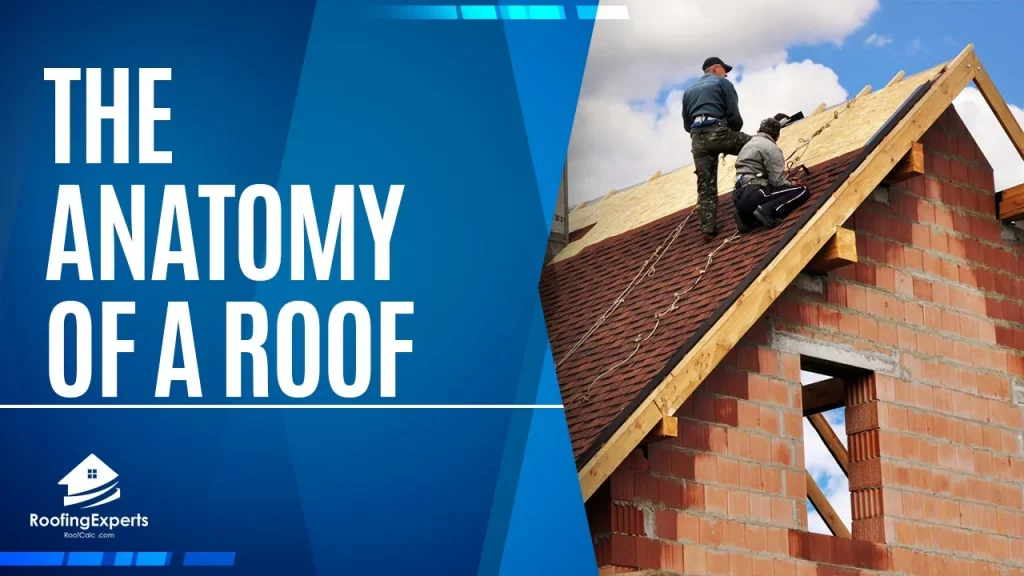
Roofs are one of the most important aspects of a building. They provide protection from water, animals, and other unwanted intruders. Whether you have an asphalt roof or clay tiles, there is a lot that goes into its construction.
In this blog post we will be going over The Anatomy of a Roof and discuss it’s components!
This blog post will explore the anatomy of roofs in depth so that you can learn about what makes them so special!
Definition of Roofing Materials
Roofs are typically composed of many materials. For example, asphalt roofs comprise a layer that is made from a mixture of stone aggregate and bitumen or tar.
This type of roofing material serves as an adhesive to keep all the other materials in place while also providing protection for your home.
Bituminous waterproofing underlayment is another common type of roofing material.
This underlayment is composed of asphalt-impregnated felts or papers that are used to protect your home from leaks and other issues related to water damage.
What is a Roofing System?
Roofing systems are the way that different types of roofing materials come together. These roofs can be composed of multiple layers and require a number of installation techniques depending on their complexity.
For example, clay tiles typically have an underlayment within them to help with both water drainage as well as insulation from heat sources like sunlight or fireplaces.
Asphalt roofs can also be quite complex, requiring a number of layers to come together.
The first layer is typically the base and it works as an adhesive for all of the other materials that go on top of it. There are often granules added so that this material will last longer by avoiding sun damage or water corrosion
Next comes the protective barrier that serves as the top layer. This can be made from asphalt or rubber and prevents any moisture, heat ,or other substances from getting through to the roofing system beneath it.
What are Parts of a Roofing System – The Anatomy of a Roof
Roofing systems are often made up of many different types of materials that work together. They can be composed of both organic and inorganic materials depending on the needs and abilities of the homeowner.
Roof Decking
The roof deck is the material that forms a roof’s foundation. It can be made from materials like metal, wood, or concrete and is typically designed to last for a long period of time so as not to need replacement too soon.
Drip Edge
This is a piece of material that hangs over the roof’s edge and helps to keep water from seeping underneath it. This assists with drainage while also preventing any damage from occurring due to water leaking into your home.
Shield for Water and Ice
There are a number of different materials that can be used to protect against water and ice damage. These include rubber, aluminum ,and steel.
Roof Underlayment
Roof underlayment helps to protect your home. It can be composed of many different materials including asphalt felt, paper, and synthetic materials like polyethylene or nylon.
Starter Shingles
Starter shingles are used to protect the roof’s edge while also acting as a foundation for additional layers of material. They can be made from materials like wood or asphalt and typically work with drip edges, water shields ,and insulation .
Ridge Vent
This part is designed to allow air flow in your home so that you don’t have to worry about stuffiness or other issues. It can be made from materials like aluminum, steel, and wood.
Gutters
Gutters are designed to protect your roofing system by diverting water away from the edge of them. They can be composed of many different materials but typically work with steel or aluminum .
Downspouts
Downspouts are typically made from materials like aluminum and steel. They help to protect your roofing system by directing water away from its edge and down towards the ground below .
Roofing Material
Your roofing material is what most people think of when talking about a roof. This part of the house protects you from rain, sun and hail – do not underestimate its importance!
You can’t go wrong with any of the common roofing materials such as asphalt shingles, metal roofs or cedar shake.
Some people might want to try out synthetic roofs for their home’s exterior and if you’re looking at different types then slate is one worth considering since it has been around far longer than other options like synthetics have had time enough in-existence to make an impact!
Roof Flashing
Roof flashing is an important part of your roofing system. It works to prevent leaks and can be made from materials like lead, aluminum ,and steel .
This helps keep water out by adding a barrier at the edge of where one section meets another.
Roof flashings are vital when it comes to preventing leakage through this otherwise vulnerable area in your roofing system.
More Roofing Options
You can have more roofing options to check out, and all these would depend on what you want and with some considerations like your climate.
Roofing materials like slate, metal roof and rubber roofs may be a better option for you depending on your climate.
Asphalt roofs can also be quite complex, requiring a number of layers to come together. The first layer is typically the base and it works as an adhesive for all of the other materials that go on top of it.
There are often granules added so that this material will last longer by avoiding sun damage or water corrosion.
The next layer is the protective barrier that serves as the top layer. This can be made from asphalt or rubber and prevents any moisture, heat ,or other substances from getting through to the roofing system beneath it.
Asphalt roofs are quite popular due to their affordability and ease of use in comparison with clay tiles for example.
They may not be the most aesthetically pleasing, but they do serve a useful purpose in protecting your home from water damage and other risks.
Types of Roofs
There are many types of roofs, ranging from flat roofs to domes. The most basic form of a roof is a flat roof.
As the name suggests, this is an even surface like a deck or patio. This type of roofing material requires proper drainage to prevent leakage and damage to your home’s foundation.
Gable roofs are one of the more common types of roofs found on homes in many countries including Sweden, Japan, Germany, Norway among others. Gable roofs have two sloping surfaces that meet at a ridge.
The angles of the roof planes are typically equal and they do not extend beyond the walls below them, making this type of roofing material very easy to construct!
Other types of roofs include mansard or French rooftops which feature two slopes on each side with a flat section in the center.
Another common roofing type is a saltbox or mono-pitched roof which has one side that is longer than the other and slopes down to only one end of your home’s foundation.
Natural Roofing Materials
There are many natural materials used for roofs, such as clay tiles made from terra cotta and concrete tiles made from concrete. These roofing materials are very flat and typically have a high durability to weight ratio, making them perfect for home roofs.
Asphalt shingles are one of the most common types of natural roofing material in North America due to their affordability and ease of installation process.
They too feature two slopes that meet at a ridge point and can be made from organic materials such as fiberglass and cellulose.


